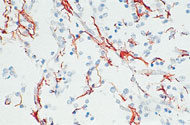345860 Sigma-AldrichAnti-Glial Fibrillary Acidic Protein Rat mAb (2.2B10)
This Anti-Glial Fibrillary Acidic Protein Rat mAb (2.2B10) is validated for use in ELISA, Immunoblotting, Frozen Sections, IP, Paraffin Sections for the detection of Glial Fibrillary Acidic Protein.
More>> This Anti-Glial Fibrillary Acidic Protein Rat mAb (2.2B10) is validated for use in ELISA, Immunoblotting, Frozen Sections, IP, Paraffin Sections for the detection of Glial Fibrillary Acidic Protein. Less<<Sinônimos: Anti-GFAP
Produtos recomendados
Panorama geral
| Replacement Information |
|---|
Tabela com principais espec.
| Species Reactivity | Host | Antibody Type |
|---|---|---|
| B, H, M, R | R | Monoclonal Antibody |
Preço e Disponibilidade
| Número de catálogo | Disponibilidade | Embalagem | Qtde/Emb. | Preço | Quantidade | |
|---|---|---|---|---|---|---|
| 345860-100UG |
|
Ampola plástica | 100 μg |
|
— |
| References | |
|---|---|
| References | Tohyama, T., et al. 1993. Am. J. Pathol. 142, 871. Lee, V.M., et al. 1984. J. Neurochem. 42, 25. |
| Product Information | |
|---|---|
| Form | Liquid |
| Formulation | In PBS. |
| Positive control | Human or rat brain tissues |
| Preservative | ≤0.1% sodium azide |
| Quality Level | MQ100 |
| Physicochemical Information |
|---|
| Dimensions |
|---|
| Materials Information |
|---|
| Toxicological Information |
|---|
| Safety Information according to GHS |
|---|
| Safety Information |
|---|
| Product Usage Statements |
|---|
| Packaging Information |
|---|
| Transport Information |
|---|
| Supplemental Information |
|---|
| Specifications |
|---|
| Global Trade Item Number | |
|---|---|
| Número de catálogo | GTIN |
| 345860-100UG | 04055977214413 |
Documentation
Anti-Glial Fibrillary Acidic Protein Rat mAb (2.2B10) MSDS
| Título |
|---|
Anti-Glial Fibrillary Acidic Protein Rat mAb (2.2B10) Certificados de análise
| Título | Número do lote |
|---|---|
| 345860 |
Referências
| Visão geral de referência |
|---|
| Tohyama, T., et al. 1993. Am. J. Pathol. 142, 871. Lee, V.M., et al. 1984. J. Neurochem. 42, 25. |








